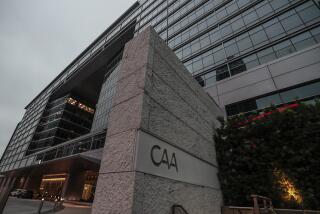Ad Agencies Sponsor New Image, Expand Services
- Share via
NEW YORK
Don’t call them just ad agencies anymore.
Aiming to broaden their services beyond their signature specialty, advertising firms increasingly are delving into areas such as direct marketing, strategic planning, interactive communications, public relations and even corporate logo design.
Saatchi & Saatchi is the latest to expand into the so-called arena of co-marketing, which involves matching manufacturers with retailers and developing in-store displays, synergistic advertising and other promotions at the retail level.
At a news conference on Wednesday, the agency said it acquired GMG Marketing Services, a Philadelphia firm specializing in bridging manufacturers such as Pillsbury, Unilever, Pepsi and Reynolds Metals with stores that sell their products. GMG Marketing Services now becomes Saatchi & Saatchi Co-Marketing Services with headquarters in New York.
“We want to be revered as a hot house for creative ideas,” said Bob Seelert, chief executive at Saatchi & Saatchi, which last year demerged from Cordiant. (Seelert did not disclose terms of the deal.)
Saatchi & Saatchi has seized on a trend among ad firms to recast themselves as “ideas companies” or “communication specialists” amid growing pressure from clients needing more than just advertising advice. Increasingly, companies have tapped consulting firms for strategic branding advice or ways to position their products.
“Management consultants have usurped the power from ad agencies, so ad agencies now are trying to figure out how to gain the same credibility,” said Rance Crain, editor of Advertising Age. “Clients think of ad agencies as interchangeable pawns. They’ll go to whichever agency is cheaper. So the agencies have to say: ‘We’ve got ideas. We’re worth what we charge.’ ”
But Crain is skeptical that advertising firms can convince clients of their wide-ranging expertise.
“They’re emulating their competitors, but I don’t think that’s going to work,” he said. “The traditional ad agency is really in flux. They don’t know what they want to be when they grow up.”
With about $30 million in annual billings, GMG gives Saatchi & Saatchi a head start in the fast-growing co-marketing sector estimated at $1 billion.
An example of co-marketing would be how GMG helped Albertson’s drive sales at their grocery stores. At GMG’s suggestion, the grocery chain designated food demonstration areas where customers could sample recipes and easily purchase products included in those recipes.
“Retailers now see themselves as brands and want to differentiate themselves from their competitors,” said Mel R. Korn, GMG’s president who will head up Saatchi & Saatchi’s new division. “Co-marketing is becoming the way to do business.”
Saatchi & Saatchi is not the first ad agency to involve itself in this line of marketing. Grey Advertising owns a marketing firm, J. Brown/LMC Group, which has Procter & Gamble as a client.
Grey also has divisions in direct marketing, public relations, health-care marketing, online services, design and promotions and technology marketing.
“Over the past five years, more clients have come to us for integrated services,” said Toni Lee, Grey’s spokesperson. “They’re trying to reach consumers in lots of different places, and they need to have all kinds of marketing tools at their disposal.”
Young & Rubicam, which went public earlier this week, last month acquired a Connecticut consulting firm, Capital Consulting & Research. It will fold the company into its Wunderman Cato Johnson unit, which specializes in database marketing and direct mail.
Foote, Cone & Belding in New York also has been aggressively moving into direct marketing, Internet services and strategic planning. President Charlie Taney said almost a third of the firm’s total revenues now come from its direct marketing unit.
“Although advertising is critically important, it’s only a part of our agency’s plan,” he said.
But Taney acknowledged that convincing clients that the agency has as much expertise in strategic planning as advertising has not been easy.
“Clients are wary because they want the best in class for each service,” he said. “Let’s face it. While we’d like to provide these other services, one thing we do for clients that they can’t do for themselves is create brilliant advertising. When all is said and done, that’s our power alley.”
More to Read
Inside the business of entertainment
The Wide Shot brings you news, analysis and insights on everything from streaming wars to production — and what it all means for the future.
You may occasionally receive promotional content from the Los Angeles Times.










